SWT/KWS MT KENYA MOBILE VETERINARY UNIT
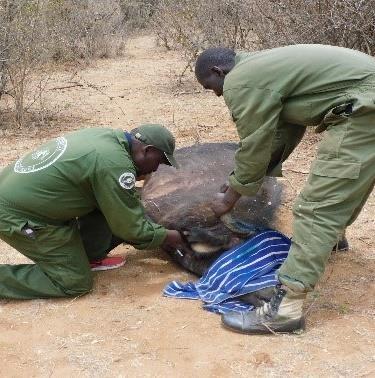
MARCH 2023

Introduction
10 Cases in March
March Report by Dr. Jeremiah Poghon

5 Rhino Cases
Success
During the month of March 2023, the Mt Kenya Wildlife Veterinary unit attended to 10 wildlife cases that required veterinary intervention in Laikipia ecosystem and Mt. Kenya region. Some of the wildlife cases include a speared elephant in Mpala ranch, a buffalo that was rescued from a pit in Lol daiga Ranch, a stray oryx rescued from Naibor center and taken to Tundra farm, snared zebra treated in Balungi farm, a Black rhino treated in Sera Sanctuary and an autopsy of a White rhino carcass in Ol pejeta Conservancy. The rains have started and we expect the drought to stop and cases to reduce.
Acknowledgement
The Unit acknowledges the Senior Assistant Director, Mountain Conservation Area and the head of Veterinary services, Kenya Wildlife Service for providing the leadership and technical expertise for the Unit. The Unit also appreciates Sheldrick Wildlife Trust (SWT) for providing financial and other logistics to allow the Unit to deliver its mandate.

Case Details
buffalo fell into a dry water hole after being driven from a farm by KWS rangers.

70%
Date Species Area Found Reason for Intervention Outcome 1-Mar-23 Rhino White Ol Pejeta Conservancy Postmortem The rhino was treated for territorial fight wounds, but succumbed to the injuries Died 2-Mar-23 Zebra Balguni, Laikipia Snared The wire snare that was deep cutting was cut loose on the left front limb Successfully Treated 2-Mar-23 Antelope Naibor Conservancy HWC Oryx lost its way
county Task Successful 5-Mar-23 Rhino Black Lewa Conservancy Natural Causes Weakness
mating Died 6-Mar-23 Elephant Mpala Ranch Spear Had
Successfully Treated 12-Mar-23 Rhino
Conservancy Natural
There
Prognosis Poor 13-Mar-23 Elephant
karama Ranch Natural Causes Numerous
Successfully Treated 14-Mar-23 Rhino
Conservancy Technical Cases Ear-notching
Task Successful 14-Mar-23 Rhino White
Conservancy Technical Cases Ear-notching
Task Successful 15-Mar-23 Buffalo Sera
Conservancy HWC A
Successfully Treated
and entered a building at Naibor trading centre in Laikipia
of the left hip due to a dislocation suspected to have occurred during
a spear stuck on his back near the thoracic spine
Black Sera Wildlife
Causes
were several penetrating wounds caused by territorial fight with another bull
El
puncture and laceration wounds possibly caused by a lion attack
Black Lewa
provides rhinos with markings to enable positive identification
Lewa
provides rhinos with markings to enable positive identification
Wildlife
Mobile Vet Unit Treatment Locations
March 2023
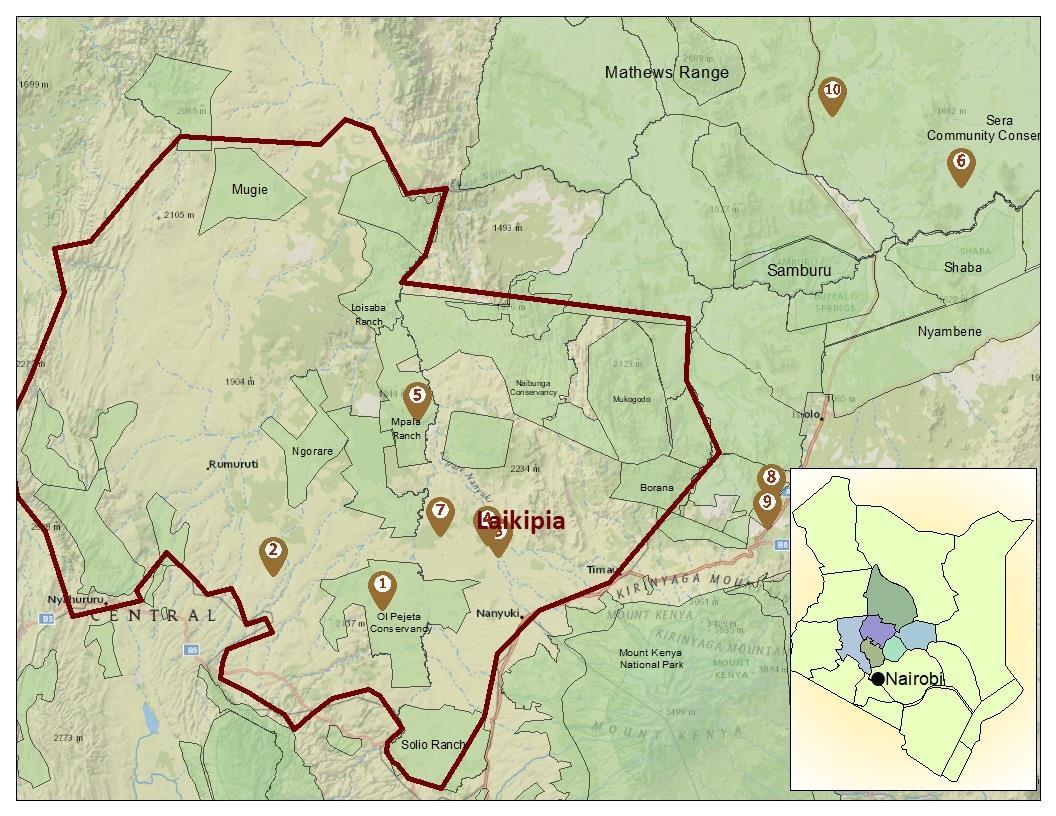
SWT/KWS Mount Kenya
Case 1 – 1st March 2023
White Rhino Post-mortem Ol pejeta Conservancy
The White rhino, named Attan, was last a week prior looking healthy after foraging normally. The rhino was treated on 22/01/2023 for territorial fight wounds with another bull and recovered well. Then on the 1st March 2023 the rhino’s carcass was found after intense patrols by Ol pejeta and KWS rangers in the area.
Post-mortem examination
The carcass was lying on the right side and having undergone advanced level of autolysis and scavenging. The head and the horns were intact, but the trunk was opened and all intestinal contents emptied out by scavengers and only the rib cage was left intact.

The left front and hind limbs had been torn from the carcass and dragged meters away. No flesh was left on the pelvic region and only the skeletal anatomy remained.
Cause of Death
There were no organs left for meaningful autopsy to be undertaken to ascertain the cause of death.
Zebra Snared Balungi Farm, Laikipia
The zebra was reported to be snared by the ranch owners but when the team rushed to the area the shy zebra vanished into the bushes. The second time the zebra was found and quickly darted.
Immobilisation, examination and treatment
The zebra was immobilised using 6mg Etrophine hydrochloride mixed with 60mgs of Azaperone delivered using a Dan-Inject CO2 rifle, fired from foot. The dart landed on the musculature of the right shoulder and induction time was 7 minutes. The animal ran and briefly disappeared into the bushes but was found on left lateral recumbency then blindfolded to avoid light stimulation.

The wire snare was deep and cutting into the muscles of the left front limb. The wire was cut loose and the wound cleaned with Hydrogen peroxide and tincture of Iodine. A topical antibiotic was sprayed onto the wound before a final cover of green clay was applied.
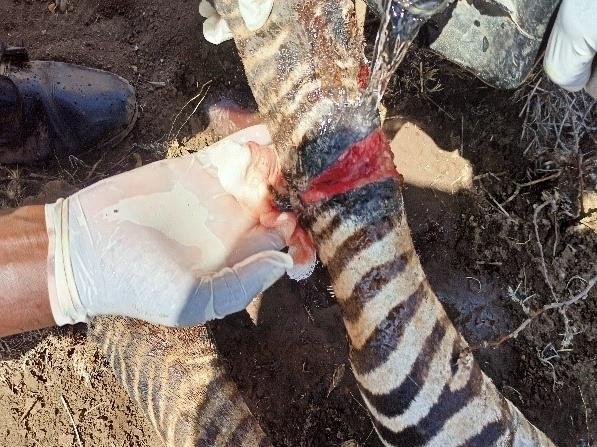
Amoxicillin LA was given intramuscularly for systemic antibiotic cover and Dexamethasone administered to manage pain and inflammation. A metabolic stimulant was also given to promote appetite and boost immunity.
Reversal and Prognosis
Reversal was achieved using 120mgs of Naltrexone administered through the jugular vein. The animal woke up and joined his group with a good prognosis for full recovery.
Case 2 – 2nd March 2023
Oryx Relocation
Naibor Wildlife Conservancy
The oryx lost its way and entered a building at Naibor Trading Centre in Laikipia county. Local members alerted KWS Laikipia Station who relayed the information to Mt Kenya Vet unit. The team rushed to the area and found the lone female oryx inside a pub with many people surrounding it.

Immobilisation
The oryx was darted using 6mg Etrophine and 70mgs of Azaperone delivered using a Dan-Inject CO2 rifle, fired from foot. The dart was delivered to the musculature of the right thigh and induction time was 8 minutes. The animal went down on sternal recumbency and was blindfolded to avoid light stimulation.
Relocation
The oryx was loaded onto a land-cruiser truck and relocated to the nearby Tundra farm which is fenced and has other wildlife including oryx. She was released in an area with plenty of water and forage. Reversal was done by administration of 120mgs of Naltrexone intravenously. The oryx woke up and ran to the lush bushes.
Prognosis
Prognosis is good.
3 – 2nd March
Case
2023
Black Rhino Natural Causes Lewa Conservancy

This Black rhino was observed on the evening of 4th March 2023 to have hind limb weakness and was unable to use the hind legs especially the left one. Due to lateness of the report the ground team was requested to secure the rhino until the next day. Close examination revealed the rhino could not use both the hind limbs and even when approached she could only stretch the front legs attempting to stand up in vain. The local rangers reported that the rhino was in estrus and was being mounted by a bull 3 days before.
Immobilisation
The rhino was immobilized using 4mgs Etorphine Hcl and 60mgs Azaperone delivered by Dan-inject dart gun. It was darted from foot, and it took abouts 5 minutes for the rhino to be immobilized. Physical examination revealed weakness of the left hip joint that occurs during dislocation. The dislocation was suspected to have occurred during mating. Recumbency leads to complications such as downer syndrome plus the rhino not feeding and drinking water. Putting the rhino in a boma to prevent predation was considered but with the poor prognosis of recovery, euthanasia was the only option to save the rhino from further suffering. Having considered all the options, the Unit request the Authorities for permission to euthanize the rhino.
Post-mortem examination
The skin and muscles were carefully removed and the left hip joint exposed which revealed that the hip joint was dislocated. This caused weakness of the joint and attempts by the rhino to use the limb led to luxation of the knee joint too. The right hind limb appeared normal and the cause of not being active may be attributed to weakness from the rhino lying on it leading to reduced blood flow and nerve sensation.
Case
– 5th March
4
2023
Elephant Spear Mpala Ranch, Laikipia
A sub-adult, male elephant was reported by Mpala Research Rangers to have a spear stuck on his back near the thoracic spine. The Mt Kenya Veterinary Team rushed to the area and found the lone young bull under a shade with the spear head still stuck at the thoracic area.


Immobilisation, examination and treatment
The elephant was immobilised using 10mgs Etrophine hydrochloride. He was darted with a Dan-Inject® CO2 rifle, fired from the foot. The dart was delivered on the musculature of the right rump and induction time was 7 minutes and the animal went down on left lateral recumbency.
The deep penetrating spear was carefully pulled out and the wound cleaned with tincture of Iodine and topical antibiotic spray. The wound was then sealed with healing clay.
Amoxicillin was given intramuscularly for systemic antibiotic cover and Phenylbutazone administered to manage pain and inflammation.
Reversal and Prognosis
Reversal was done using 200mg of Naltrexone was administered through the ear vein. The animal was standing in 3 minutes.
Prognosis good.
Case 5 – 6th March 2023
.
Black Rhino Natural Causes Sera Wildlife Conservancy
The report was made by Sera Rhino Sanctuary of an injured black rhino bull thought to have been injured through territorial fight with another bull. The bull had also lost body condition due to the prevailing drought conditions. The vet was airlifted to the sanctuary.

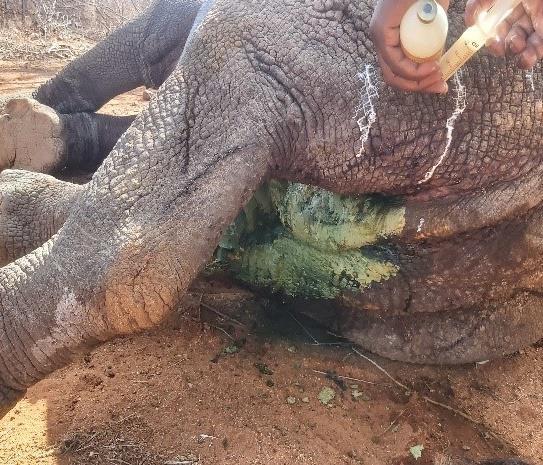
Immobilisation, examination and treatment
The rhino was darted from a helicopter with 4.5mgs Etrophine hydrochloride and 80mgs of Azaperone delivered using a Dan-Inject® CO2 rifle. The dart was delivered on the musculature of the right rump and induction time was 4 minutes with the animal going down in left lateral recumbency.
There were several penetrating wounds on the perineal area caused by a territorial fight with another bull. The bull was also very thin with a body condition of 2.5/5 scale. This was caused by the prevailing drought conditions in the region.
The wounds were treated with Hydrogen peroxide mixed with water and splashed with tincture of Iodine before being covered with green clay.
The Black rhino was administered with long-acting Amoxicillin, Dexamethasone and Vitamin B12 complex.
Reversal and Prognosis
A guarded prognosis was given.
The rhino was reversed by administration of 16mgs of Diprenorphine Hcl intravenously. The rhino stood up and walked away calmly.
– 12th March
Case 6
2023
Elephant Natural Causes El karama Ranch

A young elephant calf was reported to have numerous puncture and laceration wounds across the body mostly likely caused by an attack from a lion trying to predate on the calf. The calf was weak but still struggling to stay with the mother. The report was made by El karama Conservancy Rangers.

Immobilisation, examination and treatment
The elephant’s calf mother was immobilized using 16mgs Etorphine hydrochloride delivered using a DanInject® CO2 rifle, fired from a vehicle. The dart was delivered on the musculature of the right rump. Induction time was 5 minutes, and the animal went down on right lateral recumbency.
Due to the age of the calf, he was physically restrained, and topical treatment initiated. The wounds were cleaned using Hydrogen peroxide mixed with water then flushed with tincture of Iodine and topical clay applied before a final cover of green clay was used to cover the wound. Long-acting antibiotics and antiinflammatories were also administered.
Reversal and Prognosis
Reversal of the mother was achieved through 200mg of Naltrexone administered through the ear vein. The animal was standing within 3 minutes and the calf left to join the mother. They both walked away slowly
Prognosis good.
Case 7 – 13th March 2023
Buffalo Human-Wildlife Conflict Lol Daiga Ranch
The report was made by the manager of Lol daiga hills Wildlife Sanctuary of a buffalo that fell into a dry water hole after being driven from a nearby farm by KWS rangers. The animal was spotted the next morning and reported to Mt Kenya veterinary team who rushed to the area and found the buffalo struggling to climb the steep sides. A backhoe tractor was called in and drugs prepared to immobilize the buffalo.


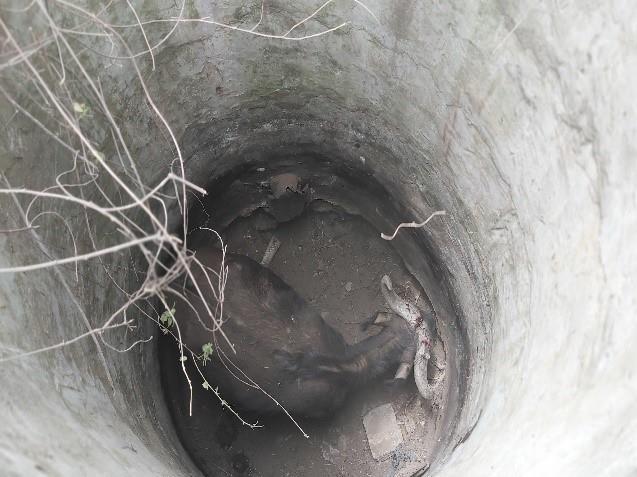
Rescue and Relocation
The buffalo was immobilized using a combination of 6mgs Etorphine Hcl and 80mgs Azaperone delivered by a Dan-inject dart to the rump area. It took 5 minutes for the animal to be completely immobilized.
A ranger was slowly lowered to the 10-meter hole where he safely hooked the straps onto the horns and secured them tightly. The ranger was assisted out and the buffalo pulled out slowly using the backhoe tractor and loaded onto a truck.
He was placed in a sternal position and relocated into the conservancy where he was released after anaesthesia was reversed using 120 mgs of Naltrexone Hcl. He woke up and ran into nearby bushes. .
–
Case 8
14th March 2023
Black/White Rhino Technical Cases Lewa Conservancy
Successful management of rhinos requires reliable and efficient field monitoring to make informed metapopulation management decisions. Monitoring of rhino populations is done using an individual identitybased approach to collect accurate data. This is aided by ear notches to ensure that all animals can be reliably identified. Ear-notching is an adopted and verified system that provides rhinos with markings on specific areas of the ears where each animal gets a unique code to enable positive identification. A rhino that cannot be identified through notches and other conspicuous body features is referred to as a ‘clean’ rhino.
Ear Notching Exercise
The exercise took place from 6th to 14th March 2023 and targeted 20 black and 22 white rhinos. Funding was provided by the USFWS and Tusk Trust. The ear-notching exercise was jointly carried out by the Kenya Wildlife Service (KWS), Lewa Wildlife Conservancy (LWC), and Borana Conservancy (BC), Wildlife Research and Training Institute (WRTI) and Association of Private and Community Land Rhino Sanctuaries (APLRS).
All the rhinos were darted with a Dan-inject dart containing Etorphine Hcl and Azaperone Hcl (40mg/ml). The dose rate was dependent on age and body size, with adults being darted with 4.5 mg Etorphine combined with 80mg Azaperone and sub-adults with 3mg Etorphine combined with 80 mg of Azaperone.
All the rhinos were ear notched successfully.

Case 9 & 10 – 6th to 14th March 2023





















